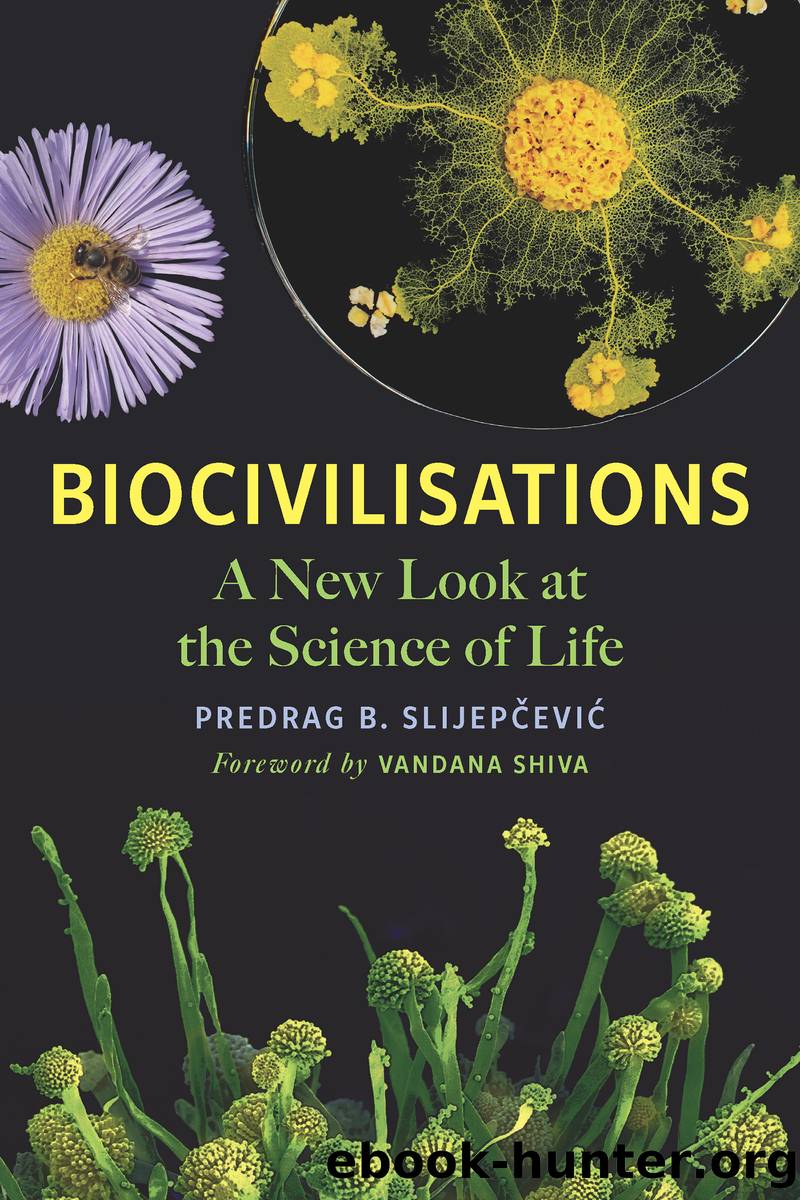Biocivilisations by Predrag B. Slijepčević

Author:Predrag B. Slijepčević
Language: eng
Format: epub
Publisher: Chelsea Green Publishing
Gaian Science versus Human Science
Strangely, Dr Doolittle ended his paper that described Darwinising Gaia by pitting human science against Gaian science. He wrote: âAnd as we enter the Anthropocene, even those who see Gaia as an organism must admit that she can be killed.â49 The notion that we humans can kill Gaia is a delusion dealt with by Lynn Margulis in her book Symbiotic Planet.50 We humans can perturb the Gaian system; there is no doubt about it. The anthropogenic ecological crisis in the form of biological annihilation and climate change is a clear sign of our impact on Gaia. But in the process of anthropogenic disturbance, we have exposed ourselves to the mercy of Gaiaâs response. Gaian hyperthought will stabilise the system with or without us.
It is essential to remember that Gaia has survived the rigours of turning a dead planet into a living one. The Oxygen Catastrophe was an endogenous event caused by life â cyanobacteria producing oxygen â that was probably far worse than anthropogenic pollution. Gaia has also survived five major extinction events in the last 600 million years.51 The KâPg extinction event 66 million years ago was likely caused by the impact of a comet or asteroid 10 to 15 kilometres in size. The energy it released was far greater than that of all nuclear weapons combined.52 Yet Gaia essentially swallowed the violence of the KâPg extinction event. Even if we wanted to kill Gaia using powerful scientific technologies like nuclear weapons, we would fail.53
The possibility of humans destroying the Earth is a fallacy promoted by at least three lines of thinking. First, modern education trains students to view our species as the most intelligent, and thus the most powerful, in the history of life. Second, modern science promotes a mechanistic outlook. Physics is the most fundamental science; given that biology is derived from physics and physics is based on reductionism and mechanism, biology is based on reductionism and mechanism by default. Third, neo-Darwinism, the most dominant ideological force in biology, is allied with the mechanistic outlook of physics. Organisms are interpreted as organic machines controlled by the nuts and bolts of genes and environments.
While we can refute the fallacy that humans are capable of destroying life on Earth by deconstructing the three assumptions on which it is based, we cannot ignore the importance of the clash between how modern science is practised and how naturalised Gaian science operates. A point of contention has recently emerged. Using chemical organisation theory and the Deficiency Zero Theorem, researcher Sergio Rubin and his colleagues have demonstrated that Gaia is an autonomous system capable of anticipation in the manner Robert Rosen described. Autopoiesis is âa more fundamental state of affairs than feedback self-regulationâ.54 The key feature of autopoietic systems is the distinction between structure and organisation. The structure may change as long as the self-producing autopoietic organisation of biological systems, including Gaia, is preserved. This means that the Gaian system may undergo dramatic structural changes, such as extinction events and other tipping points, without any impact on her autopoietic organisation.
Download
This site does not store any files on its server. We only index and link to content provided by other sites. Please contact the content providers to delete copyright contents if any and email us, we'll remove relevant links or contents immediately.
| Cell Biology | Developmental Biology |
| Entomology | Marine Biology |
| Microbiology | Molecular Biology |
| Biostatistics |
Sapiens: A Brief History of Humankind by Yuval Noah Harari(14252)
The Tidewater Tales by John Barth(12608)
Mastermind: How to Think Like Sherlock Holmes by Maria Konnikova(7227)
Do No Harm Stories of Life, Death and Brain Surgery by Henry Marsh(6890)
The Thirst by Nesbo Jo(6826)
Why We Sleep: Unlocking the Power of Sleep and Dreams by Matthew Walker(6618)
Life 3.0: Being Human in the Age of Artificial Intelligence by Tegmark Max(5474)
Sapiens by Yuval Noah Harari(5294)
The Longevity Diet by Valter Longo(5019)
The Body: A Guide for Occupants by Bill Bryson(4974)
The Rules Do Not Apply by Ariel Levy(4861)
The Immortal Life of Henrietta Lacks by Rebecca Skloot(4525)
Animal Frequency by Melissa Alvarez(4395)
Why We Sleep by Matthew Walker(4360)
The Hacking of the American Mind by Robert H. Lustig(4318)
Yoga Anatomy by Kaminoff Leslie(4306)
All Creatures Great and Small by James Herriot(4232)
Double Down (Diary of a Wimpy Kid Book 11) by Jeff Kinney(4207)
Barron's AP Biology by Goldberg M.S. Deborah T(4097)
